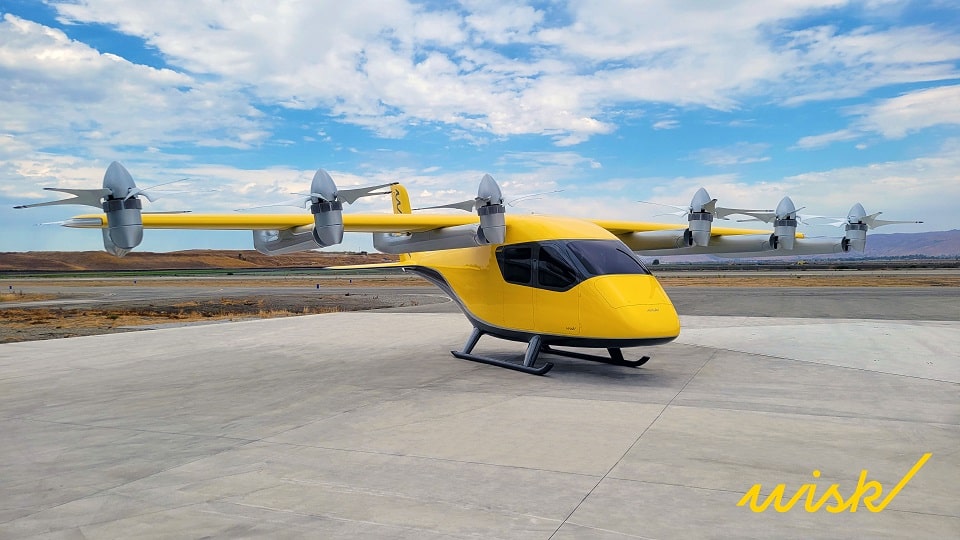Aerospace
Boeing unveiled its Generation 6 eVTOL Wisk aircraft at the Paris Airshow.

A new era in pilotless flight will begin on Sunday when Boeing subsidiary Wisk Aero makes its all-electric, autonomous sixth-generation air taxi premiere at the Paris Air Show.
A 90-mile range, a 15-minute charge time, and a cruising speed between 110 and 120 knots are just a few of the outstanding features of the WISK Explore Generation 6 air taxi. The air taxi can hold four people with their luggage comfortably and flies at altitudes of between 2,500 and 4,000 feet.
Pilotless Planes Could Save Airlines $35 Billion Per Year(Opens in a new browser tab)
The CEO of WISK, Brian Yutko, claimed that in 2023, the California-based aerospace company will become a wholly-owned subsidiary of Boeing, despite the fact that Boeing declined to comment. By working together strategically, WISK may benefit from Boeing’s development, testing, and certification know-how while also improving its financial standing.
The company has made outstanding advancements in electric aviation technology with more than 1,600 test flights and several generations of aircraft. The Federal Aviation Administration (FAA) will choose whether to certify a product and when to begin offering services. However, Yutko asserted with confidence that WISK air taxi services would be accessible within this decade.
Exclusive: Inside the C-390 Millennium demonstrator at Aero India 2023(Opens in a new browser tab)
The human-oversight design process used to create WISK’s air vehicles ensures high safety standards and prevents single points of failure. Specific launch cities have not yet been disclosed, although the business intends to initially introduce its services throughout the United States.
Yutko outlined the company’s ambitious plan to grow to 20 cities within seven years of certification, focusing on well-known cities that might serve as possible launch sites.A Multi-Vehicle Supervisor will oversee each flight from the ground, opening up new employment prospects in the aviation industry.

Aerospace
Boeing Transfers Rocket Stage to NASA, Paving Way for Human Moon Mission

Boeing has achieved a significant milestone by providing NASA with the second core stage of the Space Launch System (SLS) rocket.
This crucial component, crafted at NASA’s Michoud Assembly Facility (MAF), is set to propel the Artemis II crew into lunar orbit, marking humanity’s return to deep space after a 50-year hiatus.
The monumental Boeing-built rocket stage, the largest element of the Artemis II mission, will embark on a journey aboard the Pegasus barge, traveling 900 miles to NASA’s Kennedy Space Center.
Comparison of two legendary aircraft B777x vs B747 aircraft:Click here
Upon arrival, it will be meticulously integrated with other essential Artemis II components, including the upper stage, solid rocket boosters, and NASA’s Orion spacecraft within the iconic Vehicle Assembly Building. This intricate integration process is a vital step toward the eagerly anticipated Artemis II launch, slated for 2025.
“Boeing-built products helped land humankind on the moon in 1969, and we’re proud to continue that legacy through the Artemis generation,” remarked Dave Dutcher, vice president and program manager for Boeing’s SLS program. “Together, with NASA and our industry partners and suppliers, we are building the world’s most capable rocket and paving the way to deep space through America’s rocket factory in New Orleans.”
NASA, Lockheed Martin Reveal X-59 Quiet Supersonic Aircraft:Click here
The delivery of Core Stage 2 marks a significant achievement in the evolution of the SLS rocket. Towering over 200 feet and powered by four RS-25 engines, this core stage, coupled with two solid-fueled booster rockets, will generate a staggering 8.8 million pounds of thrust. This immense power is crucial to launching Artemis II and future missions into the vast expanse of space.
The SLS rocket stands unparalleled in its capability to transport both crew and substantial cargo to the moon and beyond in a single launch. Its extraordinary capacity will facilitate the delivery of human-rated spacecraft, habitats, and scientific missions to destinations including the moon and Mars, ushering in a new era of space exploration.
-

 Travel1 week ago
Travel1 week agoAir India to Expand US Operations with Three New Routes After a Decade
-

 Travel2 weeks ago
Travel2 weeks agoWhy We Should Avoid These Stamps in a Passport
-

 Airlines1 month ago
Airlines1 month agoInvestigations Reveal Fake Chinese Titanium in Boeing and Airbus Jets
-

 Tech4 weeks ago
Tech4 weeks agoChina’s CATL Plans 1,800-Mile Electric Plane Launch by 2027
-

 Airport3 days ago
Airport3 days agoTop 10 Largest Airports in the World by Size
-

 Aerospace4 weeks ago
Aerospace4 weeks agoChina’s Fighter Jets Turn Wings into Autonomous Drones
-

 Airlines4 days ago
Airlines4 days agoAir India Rolls Out A350s for Delhi-New York JFK and Newark Routes
-

 Defence3 weeks ago
Defence3 weeks agoBoeing Enhances Chinook with New Engines and Block II Upgrades at $96 Million







